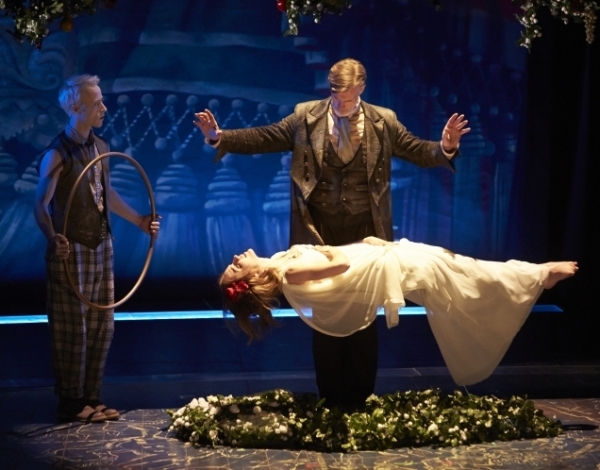The Tempest

(© The Smith Center/Geri Kodey)
American Repertory Theater‘s The Tempest is rife with "rough magic" — and some that’s exquisitely smooth, as when Prospero, rather than summoning a raft of goddesses to bless the gifting of Miranda to Ferdinand, reverently levitates his daughter to the strains of Tom Waits’ "Shiny Things." This Tempest, a coproduction with Las Vegas’ Smith Center for the Performing Arts, is filled with prestidigitation, and no wonder: It’s adapted and directed by Aaron Posner and Teller, the small, silent, illusionist half of Penn & Teller, with "magic design" by Vegas legend Johnny Thompson.
But the biggest miracle is that Shakespeare’s fable more than survives the card tricks and disappearing acts. The play — the last attributed to Shakespeare alone — tells the tale of Prospero, wrongfully deposed Duke of Milan and a skilled sorcerer, set to sea with his infant daughter some years ago. He has since colonized an island and, as the play opens, his enemies have drifted into his orbit. But his urge to revenge, though strong, is upended when his daughter, now grown, falls for the son of one of them. Though pared down, this Tempest is actually enriched by the vivid enactment of the relationship of Prospero to his magic. Apart from "Full fathom five," attributable to the Bard, the songs in the production are from the catalogue of Waits and his wife/collaborator, Kathleen Brennan. And though strangely beautiful when divorced from Waits’ trademark rasp, most of the tunes are about love, loss, and dying. They play like a slow, keen build up to the island magician’s difficult renunciation of his "art" for a courtly life "where/Every third thought shall be my grave."
One inspiration for the staging was a Dust Bowl magician called Willard the Wizard, who barnstormed with his young daughter as his assistant. So Daniel Conway’s multilevel wooden set is more carny than Caribbean — though it does boast a ship’s steering wheel, an ornately framed island landscape, an Elizabethan inner stage, and tattered curtains ideal for shadow play. In the beginning, as Prospero’s usurping brother and his cronies come close to his island and are subjected to a shipwreck, Tom Nelis’ lanky magician and his eerie platinum-topped sprite, Ariel (the deft Nate Dendy), plunge an origami boat into a large glass bowl of water. Clearly they are conjuring the "wrack," but that’s just the first spell of the evening. One more is cast by the four-person band, aptly called Rough Magic, whose two female soloists, Miche Braden and Shaina Taub, mix Kurt Weill with the blues and siren song.
But back to Shakespeare’s play, in which the deposed Duke of Milan torments his usurpers before forgiving them to the point of giving up his daughter and his magic powers. Seldom has Shakespeare’s farewell to art seemed as painfully valedictory as Nelis makes it. More smoldering than fiery in carrying out his revenge, he is magisterial in the second half of the play, lending authority, lyricism, and great regret to the breaking of his staff (into a shower of golden sparks) and the drowning (into thin air) of his book. And as the sorcerer’s right-hand spirit, Dendy is both otherworldly and dexterous, producing cards and other small marvels from his very pores — or so it seems.
The production’s choreographer is Matt Kent, associate artistic director of Pilobolus and a former dancer with that muscular troupe. His main contribution is a two-headed, four-legged Caliban formed by the cartwheeling tangle of actor Zachary Eisenstat and dancer Manelich Minniefee. These two make a marvelously conjoined "monster": spawn of the witch Sycorax and resentful slave to Prospero. Given the choral readings of Caliban’s lines, some of the poetry in his evocation of the island’s "sounds and sweet airs" goes missing. But the physical image is both torturous and striking.
As if to lighten things up, Caliban’s shipwrecked sidekicks, the drunken butler Stephano and the jester Trinculo (here musicians in the court of King Alonso, so they can get in on the Waits fest), are broad comic creations. Eric Hissom’s Stephano, in particular, in his shades and his cups, is quite the freewheeling ham, regularly venturing into the audience and out of Shakespeare’s text. And as the wet-behind-the-ears lovers Miranda and Ferdinand, Charlotte Graham (in a dress that graduates from the color of sand to that of the sea) and Joby Earle are almost goofily adoring. Looking lustfully toward the "brave new world" of love and sex, they generate a giddy magic of their own.











